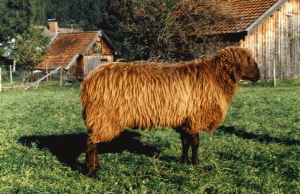Braunes Bergschaf (D)
Description
It is a medium-sized to large, unicolored brown local sheep of the Alpine Region. The narrow head has a Roman nose, is polled and carries broad and hanging ears. The Fleece consists of a cognac-colourd to deep brown wool.
General and History
The breed descended from Steinschaf and was later on influenced by Bergamasca, too. Mountain farmers kept coloured sheep to produce natural-coloured loden. From 1900 onwards, they were replaced by White Mountain sheep and becam nearly extinct in Bavaria. In the 1970ies, several breeders in Upper Bavaria started to purebred this rare breed. A herdbook was founded in 1977.
Distribution in the past and today
Germany: Oberbayern, Austria: Tirol, Switzerland: Unterengadin, Italy: Vinschgau and Ultenvalleyl.
Utilization
Main use is lamb production, landscape management and sometimes wool production. The animals are mostly kept by part-time farmers.
Keeping
The breed Brown Mountains ist the second most important Bavarian breed of teh Alps and the pre-alpine region. During summer, the animals stay on high-altitude pastures or in paddock on the extensive grassland at the foothils of the Alps. Housing during wintertime lasts for 4-6 months
Breeding aims
Breeding of al well-adapted sheep for rough high-mountain sites, early maturing with best maternal characteristics, longevity, high fertility.
Performance
Body weight: 85-110kg (m), 70-80kg (w)
Withers height: 80-85cm (m), 72-80cm (w)
Fleece weight: 6-8kg (m), 4-6kg (w)
Trading life weigth: 25kg with 7 months
Literature
Grasegger, J. (1994): Das Braune Bergschaf. Der Bayerische Schafhalter, 34 - 37
Schafrassen in den Alpen, Antje Feldmann, Ursula Bietzker, Dr. Christian Mendel, Gesellschaft zur Erhaltung alter und gefährdeter Haustierrassen e.V. - GEH, Bayerisches Landesanstalt für Landwirtschaft - LfL, Grub - Deutschland








